by Angela Darby
The Challenge’s origin within North America’s property development and urban planning context has significant implications for the advocacy tool’s relevance across other national contexts. To contribute to the progress of LBC internationally, this study examined the relevance of Imperative 15: Human Scale and Human Places in the Australian context, specifically focusing on medium- and high-density developments in Victoria. LBC 3.0’s Design Imperative 15: Human Scale and Humane Places attempts to foster social value both within site boundaries and across surrounding interstitial spaces by influencing built form decisions on a site-by-site basis. Imperative 15, in particular, is borne of a car-centric development model that has specific implications for equitable design. Ill-conceived application of Design Imperative 15 in Australia, a nation with distinct regulatory, economic and cultural conditions, may overlook significant opportunities for driving ongoing innovation in equitable built form.
This study represented a qualitative evaluation of the relevance of the Challenge’s Design Imperative 15 to Australian medium- and high-density built form. The research utilises both primary and secondary sources to develop case studies of Victorian built typologies. The case studies investigated were: Breese Street, Brunswick; Bull Street Terraces, Castlemaine; Pixel Building, Carlton; Queen Victoria Village, Melbourne CBD; and, Nightingale 1.0, Brunswick. These case studies formed the basis of a gap analysis determining if, and to what extent, a gap exists between ILFI objectives for Imperative 15 compared to developer engagement with the Imperative in Australia.
To download a summary of the study, click here: A.Darby – LBC 3.0 Design Imperative 15 – LFIA Research

